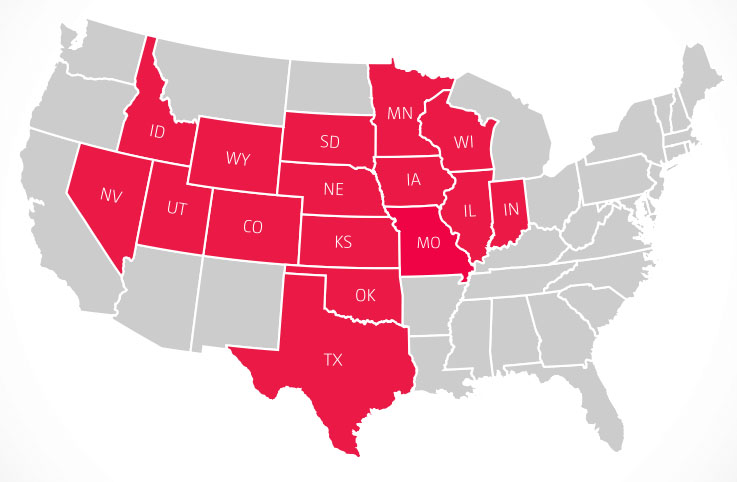Go to Reviews.org AU Edition
5 Best Rural Internet Providers 2023
We’re keeping a pulse on the latest rural broadband news, and we found Viasat, Rise Broadband, and Windstream to be great internet options for anyone out in the country.
We may earn money when you click our links.
If you’re looking for rural internet options that keep your home office and streaming apps connected, you’re in the right spot. We looked into fixed wireless internet and mobile Wi-Fi hotspots, along with DSL, cable, fiber-optic, and satellite internet to uncover the pros and cons of these potential rural internet services.
You probably Googled something like "wireless internet service providers," or "WiFi offered at my address" to get to this page. To answer those questions, just enter your ZIP code below to find the fastest internet in your area. Note that some satellite internet providers, like EarthLink or HughesNet will work just about anywhere (which is awesome).
Viasat: Best rural internet coverage
Viasat earned our pick for the top satellite internet provider thanks to its fast maximum download speeds and generous (at least for satellite internet) data caps.
By comparison, your other widely available satellite internet provider, HughesNet, offers 25 Mbps download speeds and only 15–200 GB of data.
Still, Viasat tops the satellite internet charts with up to 150 Mbps speeds and unlimited data on all of its plans. The biggest drawback? Viasat jacks up your price by $15–$50 after three months. So keep an eye on your bill and get your wallet ready.
Kinetic by Windstream: Fastest possible download speeds

Kinetic by Windstream is a fixture in many rural areas—we spotted its buildings all across northern Georgia. And while its slowest speeds cap out at 100 Mbps, you might find yourself lucky enough to get 500 or even 2,000 Mbps.
Two things to note about Kinetic by Windstream prices, though: they change based on where you live, and they go up after your first year. (But that kind of promotional pricing is normal when it comes to internet land.) Here’s a quick peek at some of Kinetic by Windstream’s pricing:
If Kinetic by Windstream’s gig speeds aren’t in your hometown yet, they might be coming soon. The ISP is building out its fiber gigabit service over the next few years.1
T-Mobile Home Internet: Best mobile home internet
*Price is with auto-pay discount applied.
If you don't like any of the ISPs in your area, you can always go the 5G home internet route. T-Mobile's 5G home internet focuses on including rural areas, and the mobile provider says almost 10 million households in the T-Mobile Home Internet coverage area are out in the country.3
One huge perk to T-Mobile Home Internet is that its $50/month price is all-inclusive: you won’t pay extra for the gateway modem-router combo or fork over cash for installation. (Unlike Verizon LTE Home Internet, which charges $10 a month or $240 for the LTE Home Router.)
One thing: Don’t expect those 100+ Mbps speeds in truly remote areas.
Rise Broadband: Best value
Rise Broadband is the 4th largest fixed wireless provider in the U.S by coverage area that offers internet service across 47 states.
If you live in Texas, Colorado, Idaho, and Illinois—we think Rise Broadband is worth a serious look.

Source: RiseBroadband.com
Fixed wireless offers decent internet speeds for a pretty decent price—at least compared to satellite internet. The only catch is that most fixed wireless providers stick you with a pretty low data cap. Even Rise Broadband does this unless you upgrade to one of its unlimited data plans.
AT&T Internet: Best rural DSL option
AT&T doesn’t necessarily call its non-fiber internet service “DSL” anymore, but we’re sticking with this term when it comes to AT&T Internet for simplicity’s sake. (AT&T calls its connection “broadband” or “IPBB,” which includes several types of DSL connections.4)
While the ISP says it no longer offers DSL internet, it does still offer internet in rural areas. If your home is pretty far off the beaten path, you could see speeds as slow as 768 Kbps—that’s less than 1 Mbps.
But for anyone closer to a city, you might get lucky with AT&T’s fiber-DSL hybrid internet connection that offers speeds up to 100 Mbps. (The 100 Mbps plan comes with unlimited data too.)
Recap: How to get internet in rural areas
- Best rural availability: Viasat. Viasat satellite internet is available in almost every part of the US, and it offers the largest data caps and fastest speeds compared to HughesNet.
- Best value: Rise Broadband. Fixed wireless is a new-ish way to get internet in the country, and Rise Broadband offers well-priced speeds and the option of unlimited data.
- Fastest possible download speeds: Kinetic by Windstream. Kinetic by Windstream is actively expanding its fiber network, meaning its competitively priced 1,000 and 2,000 Mbps plan might be available in your area.
- Best mobile internet: T-Mobile Home Internet. T-Mobile’s home internet service uses its cellular network. A similar option is available from Verizon, but T-Mobile won’t charge you for any equipment.
- Best rural DSL internet: AT&T Internet. Though it doesn’t call it “DSL,” AT&T still offers speeds between 768 Kbps and 100 Mbps in rural areas.
When shopping for rural internet options, you may be limited. But thankfully those options are growing as ISPs are working to provide more options. You might even be able to get internet through a local electric co-op if these more commonly known rural internet providers don’t extend their networks to your gravel driveway.
Another option may be a mobile Wi-Fi hotspot—or if you’re trundling across the country in your RV, there are other portable satellite internet options too. And if worse comes to worse, dial-up internet still exists. (And it’s free.)
If you keep an open mind, there’s likely a way to get connected even if you’re off the beaten path.
What to look for when buying Wi-Fi and internet for rural areas
If you’re new to rural internet, there are a few things about it that might surprise you. Here are a few things to watch out for when buying wi-fi and internet:
- Not all internet connections are equal—our first choice is cable and fiber but for rural areas, fiber may be harder to find. Then DSL (VDSL or VDSL2), then satellite, then fixed wireless, then mobile Wi-Fi hotspots, and last, dial-up.
- You may not get unlimited data or even 1 TB of data, so watch your data cap.
- Your download speeds and upload speeds may be too slow for streaming Netflix, video calls, or gaming. (Check out our best internet picks for gaming if you want to learn more.)
- Speaking of gaming, if you go with satellite internet, your latency may be too high to play first-person shooters (FPS) and other action-oriented games. Also, keep in mind that a Wi-Fi connection may not give you enough speed compared to a wired connection.
Your town may be home to a local internet provider that offers a better deal than the rural internet services we list here.
For example, my folks live in a rural part of Northern Georgia and get their internet from a local electric co-op. The price is much lower than satellite internet, and for the most part, the service holds up well.
What are internet options for rural areas?
If you have options, some rural internet providers will work better for different uses than others. In rural areas, the most widely available internet connection types are cable, DSL, and satellite. Fiber-optic is the least widely available option for internet access but it still may be an option depending on where you live. Mobile Wi-Fi hotspot internet and dial-up are also available in rural areas, although it might come at a cost. In general, here’s what we recommend.
Cable internet: Cable is our first choice for the fastest speeds and (usually) the most data at a low price. But it’s not available in a lot of remote areas, and if it is available in your area, you might pay more for it than your city slicker neighbors.
Fiber internet: Fiber-optic internet offers some of the fastest speeds and is one of the most reliable internet options. Unfortunately, it isn't as widely available as cable, DSL, or satellite may be. Luckily, most ISPs like Kinetic by Windstream are actively working on building out the infrastructure needed to bring this option to more rural towns. If it's not available where you live right now, fiber-optic internet may be an option in the future.
DSL internet: DSL may be older and slower than cable, but it’s still a solid choice thanks to lower prices and potentially higher data caps when compared to satellite internet. DSL also tends to be more widely available in rural areas, but be warned: many providers are phasing out their DSL internet service.
Satellite internet: Although it’s not our first choice thanks to its high prices and low data caps, satellite internet reaches more rural and remote areas than any other type of internet connection. So if satellite is your only option, rest assured it’s still a great internet option for the country.
Fixed wireless: Fixed wireless is a newer technology that’s still ramping up its availability. Even so, its prices tend to be a lot lower than what satellite internet providers charge, and some fixed wireless providers even offer unlimited data.
Not quite. Here are some things you should know about fixed wireless as a rural internet solution, plus how fixed wireless could become an urban internet option too.
Mobile Wi-Fi hotspot: If you need a temporary internet connection for a trek into the wild, a mobile Wi-Fi hotspot might do the trick. You may even already have Wi-Fi hotspot data included with your current cell phone plan, so there’s no need to pay extra. But watch out for small data allowances and sluggish speeds once you use all your data. If you notice your phone speeds are slow, there are a few things you can do to speed up your connection.
Want to learn more about internet for rural areas?
Our resident internet expert, Juan, chats about his challenges using mobile data and rural internet while on a trip to New Mexico. Namely, how upload speeds become even more important when you're living out in the country.
Methodology
The rankings are based on a combination of proprietary user data, online public databases, hands-on testing, and analysis of user experiences on Reddit. Based on our research and hands-on experience, we recommend Viasat, Rise Broadband, Kinetic by Windstream, T-Mobile 5G Home Internet, and AT&T DSL internet for folks living in more rural areas of the United States.
-
Proprietary User Data: To ensure comprehensive rankings, collecting and analyzing proprietary user data is essential. This data can include factors such as internet speed, reliability, customer satisfaction, and pricing. We collect user data through our speed test tool. When users perform speed tests on our website, we save the results, along with the internet service provider. Over time, we've gained millions of user speed tests that give us a clear picture of performance for users who live in more rural areas of the United States.
-
Online Public Databases: Online public databases provide a wealth of information regarding ISP performance, coverage, and customer feedback. We leverage reputable sources such as the Federal Communications Commission (FCC) and BroadbandNow to access data on speed tests, coverage maps, and other relevant metrics. This information helps us evaluate the reach, consistency, and overall quality of the ISPs under consideration.
-
Hands-on Testing: To ensure the accuracy of our rankings, we conduct hands-on testing of the ISPs. This involves subscribing to the services and evaluating various performance aspects, including internet speed, latency, and reliability. We can't travel to every corner of the country and run a speed test, but we've performed tests in rural areas of Utah, Florida, California, Arizona, and New York.
-
User Experiences on Reddit: Reddit serves as an invaluable platform for real-life user experiences and insights. By examining relevant subreddits, such as r/RuralInternet and r/ISPReviews, we gain a deeper understanding of how different ISPs perform in rural areas. These firsthand accounts help us gauge customer satisfaction, reliability, and overall service quality.
Sources
Our vote is for Viasat, Rise Broadband, Kinetic by Windstream, T-Mobile Home Internet, and AT&T as the best internet service providers for rural areas. HughesNet, AT&T Fixed Wireless, Optimum, Verizon 4G LTE Home Internet, CenturyLink, and Verizon DSL are also viable options.
But the best internet for anyone living in a rural area really depends on what’s available to you and where exactly you live. Likely you’ll have the option of satellite internet—but fixed wireless, DSL, and mobile internet tend to be cheaper and may offer more data and faster speeds.
Rural internet tends to be worse than the internet you’ll find in the city because most internet providers don’t focus on building out or upgrading their networks in rural areas.
It mostly comes down to cost. Because rural areas are home to fewer people, there are fewer households that will purchase internet service. That means there’s less money to offset the cost of building out or upgrading an internet network.
That’s a pretty short answer to something we could chat about for days. We've seen a lot of change in the internet and telecommunications industry that could see more and better rural internet options headed our way. That includes the Federal Communications Commission’s (FCC’s) Rural Digital Opportunity Fund (even though it has its drawbacks) and the growth of municipal internet providers across the country.
We recommend Viasat over HughesNet because it offers faster download speeds (up to 150 Mbps versus HughesNet's 25 Mbps) and larger data caps than HughesNet does. That said, HughesNet may fit your needs better if you don’t use the internet for more than browsing Facebook and emailing family and friends.
Technically, yes, HughesNet’s 25 Mbps download speeds are fast enough even for Netflix in 4K. Though we wouldn’t recommend streaming in 4K on a satellite internet connection because it’ll scarf down your data faster than a hungry puppy.
And keep in mind that while Netflix recommends a max speed of 25 Mbps, that’s a dedicated speed of 25 Mbps. So you likely won’t be able to stream Netflix in 4K while using any other connected devices.
We go into more detail on this very topic in our best internet for streaming and internet speed guides.
We expect 5G to eventually spread to rural areas, and you might even say it’s already started to get there with T-Mobile Home Internet.6 But 5G in the country will look and act a lot differently than 5G in the city.
The type of 5G typically used in big cities (mmWave) has a short range and trouble penetrating objects like—you guessed it—trees, hills, and mountains. Still, rural communities should see low-band 5G technology soon, which still offers an upgrade to older technology like DSL even though it’s not as speedy as mmWave 5G.
We compared the best satellite internet providers that are currently widely available, and Viasat and HughesNet came out on top. Starlink is still an up-and-coming satellite internet provider, but the company has a lot of potential and we'll continue to keep an eye on the company's progress in our Starlink Review.
Additional contributors
Related Articles








